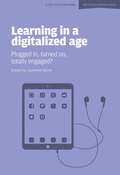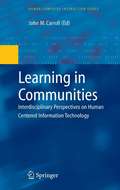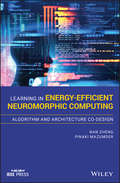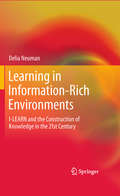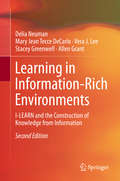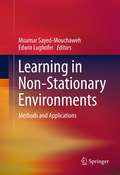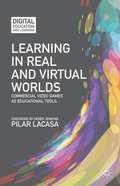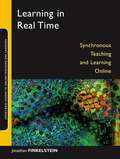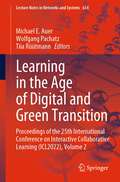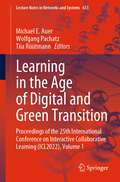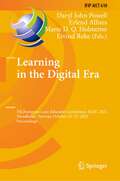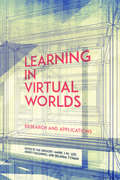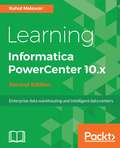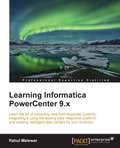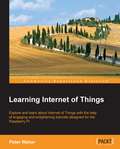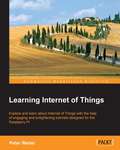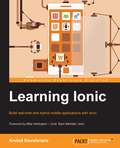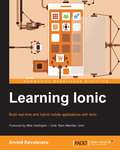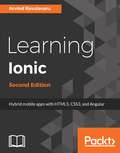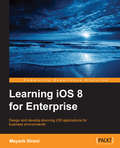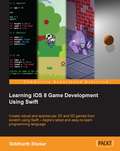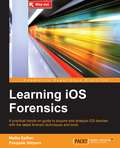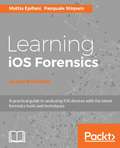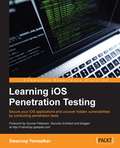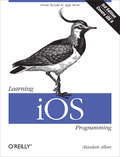- Table View
- List View
Learning in a Digitalized Age: Plugged in, Turned on, Totally Engaged? (World Class Schools Ser.)
by Lawrence BurkeAll professional learning communities agree that there is added value in utilizing technologies to enhance and facilitate student success. This volume seeks from us a critical and informed answer to one of the most important educational questions of the day: how successful will learners be in the digital age? Here, writers with real hands-on experience in the field challenge many of the assumptions about teaching and learning in the digital age. It is relevant and important for all those interested and concerned about the kinds of debates, arguments and ideas which are influencing and changing the nature of teaching and learning in the early decades of the 21st century.
Learning in Communities
by John M. CarrollMost learning takes place in communities. People continually learn through their participation with others in everyday activities. Such learning is important in contemporary society because formal education cannot prepare people for a world that changes rapidly and continually. We need to live in learning communities. This volume gathers together all of the scholarly materials directly emanating from a workshop held in August 2005, when a multidisciplinary group of scholars met at Penn State's College of Information Sciences and Technology to discuss 'learning in communities'. Initially, a sectioned report on the workshop was published as a special section in the Journal of Community Informatics in 2006. Subsequently, a special issue of 5 full papers was published in the Journal of Computer-Supported Cooperative Work, and a special section of 2 full papers was published in the International Journal of Computer-Supported Collaborative Learning.
Learning in Energy-Efficient Neuromorphic Computing: Algorithm And Architecture Co-design (Wiley - IEEE)
by Nan Zheng Pinaki MazumderExplains current co-design and co-optimization methodologies for building hardware neural networks and algorithms for machine learning applications This book focuses on how to build energy-efficient hardware for neural networks with learning capabilities—and provides co-design and co-optimization methodologies for building hardware neural networks that can learn. Presenting a complete picture from high-level algorithm to low-level implementation details, Learning in Energy-Efficient Neuromorphic Computing: Algorithm and Architecture Co-Design also covers many fundamentals and essentials in neural networks (e.g., deep learning), as well as hardware implementation of neural networks. The book begins with an overview of neural networks. It then discusses algorithms for utilizing and training rate-based artificial neural networks. Next comes an introduction to various options for executing neural networks, ranging from general-purpose processors to specialized hardware, from digital accelerator to analog accelerator. A design example on building energy-efficient accelerator for adaptive dynamic programming with neural networks is also presented. An examination of fundamental concepts and popular learning algorithms for spiking neural networks follows that, along with a look at the hardware for spiking neural networks. Then comes a chapter offering readers three design examples (two of which are based on conventional CMOS, and one on emerging nanotechnology) to implement the learning algorithm found in the previous chapter. The book concludes with an outlook on the future of neural network hardware. Includes cross-layer survey of hardware accelerators for neuromorphic algorithms Covers the co-design of architecture and algorithms with emerging devices for much-improved computing efficiency Focuses on the co-design of algorithms and hardware, which is especially critical for using emerging devices, such as traditional memristors or diffusive memristors, for neuromorphic computing Learning in Energy-Efficient Neuromorphic Computing: Algorithm and Architecture Co-Design is an ideal resource for researchers, scientists, software engineers, and hardware engineers dealing with the ever-increasing requirement on power consumption and response time. It is also excellent for teaching and training undergraduate and graduate students about the latest generation neural networks with powerful learning capabilities.
Learning in Information-Rich Environments
by Delia NeumanThe amount and range of information available to today's students--and indeed to all learners--is unprecedented. Phrases like "the information revolution", "the information (or knowledge) society", and "the knowledge economy" underscore the truism that our society has been transformed by virtually instantaneous access to virtually unlimited information. Thomas Friedman tells us that "The World Is Flat" and that we must devise new political and economic understandings based on the ceaseless communication of information from all corners of the world. The Bush administration tells us that information relating to the "war on terrorism" is so critical that we must allow new kinds of surveillance to keep society safe. Teenage subscribers to social-computing networks not only access information but enter text and video images and publish them widely--becoming the first adolescents in history to be creators as well as consumers of vast quantities of information. If the characteristics of "the information age" demand new conceptions of commerce, national security, and publishing--among other things--it is logical to assume that they carry implications for education as well. In fact, a good deal has been written over the last several decades about how education as a whole must transform its structure and curriculum to accommodate the possibilities offered by new technologies. Far less has been written, however, about how the specific affordances of these technologies--and the kinds of information they allow students to access and create--relate to the central purpose of education: learning. What does "learning" mean in an information-rich environment? What are its characteristics? What kinds of tasks should it involve? What concepts, strategies, attitudes, and skills do educators and students need to master if they are to learn effectively and efficiently in such an environment? How can researchers, theorists, and practitioners foster the well-founded and widespread development of such key elements of the learning process? This book explores these questions and suggests some tentative answers. Drawing from research and theory in three distinct but related fields--learning theory, instructional systems design, and information studies--it presents a way to think about learning that responds directly to the actualities of a world brimming with information. The book is grounded in the work of such key figures in learning theory as Bransford and Anderson & Krathwohl. It draws on such theorists of instructional design as Gagne, Mayer, and Merrill. From information studies, it uses ideas from Buckland, Marchionini, and Wilson (who is known for his pioneering work in "information behavior"--that is, the full range of information seeking and use). The book breaks new ground in bringing together ideas that have run in parallel for years but whose relationship has not been fully explored.
Learning in Information-Rich Environments: I-LEARN and the Construction of Knowledge from Information
by Delia Neuman Mary Jean Tecce DeCarlo Vera J. Lee Stacey Greenwell Allen GrantThe amount and range of information available to today’s students—and indeed to all learners—is unprecedented. If the characteristics of “the information age” demand new conceptions of commerce, national security, and publishing—among other things—it is logical to assume that they carry implications for education as well. Little has been written, however, about how the specific affordances of these technologies—and the kinds of information they allow students to access and create—relate to the central purpose of education: learning. What does “learning” mean in an information-rich environment? What are its characteristics? What kinds of tasks should it involve? What concepts, strategies, attitudes, and skills do educators and students need to master if they are to learn effectively and efficiently in such an environment? How can researchers, theorists, and practitioners foster the well-founded and widespread development of such key elements of the learning process? This second edition continues these discussions and suggests some tentative answers. Drawing primarily from research and theory in three distinct but related fields—learning theory, instructional systems design, and information studies—it presents a way to think about learning that responds directly to the actualities of a world brimming with information. The second edition also includes insights from digital and critical literacies and provides a combination of an updated research-and-theory base and a collection of instructional scenarios for helping teachers and librarians implement each step of the I-LEARN model. The book could be used in courses in teacher preparation, academic-librarian preparation, and school-librarian preparation.
Learning in Non-Stationary Environments
by Moamar Sayed-Mouchaweh Edwin LughoferRecent decades have seen rapid advances in automatization processes, supported by modern machines and computers. The result is significant increases in system complexity and state changes, information sources, the need for faster data handling and the integration of environmental influences. Intelligent systems, equipped with a taxonomy of data-driven system identification and machine learning algorithms, can handle these problems partially. Conventional learning algorithms in a batch off-line setting fail whenever dynamic changes of the process appear due to non-stationary environments and external influences. Learning in Non-Stationary Environments: Methods and Applications offers a wide-ranging, comprehensive review of recent developments and important methodologies in the field. The coverage focuses on dynamic learning in unsupervised problems, dynamic learning in supervised classification and dynamic learning in supervised regression problems. A later section is dedicated to applications in which dynamic learning methods serve as keystones for achieving models with high accuracy. Rather than rely on a mathematical theorem/proof style, the editors highlight numerous figures, tables, examples and applications, together with their explanations. This approach offers a useful basis for further investigation and fresh ideas and motivates and inspires newcomers to explore this promising and still emerging field of research.
Learning In Real And Virtual Worlds
by Pilar LacasaPacked with critical analysis and real-life examples, this book explores how video games can cultivate learning. Lacasa takes several commercial video games and shows how they can be used both in and out of the classroom to teach initiative and problem-solving, encourage creativity, promote literacy, and develop reasoning skills. The result of almost ten years spent discovering video games, learning to play, conversing with their designers and distributors, and working in the classroom with young people and teachers, Lacasa's work uncovers the educational value already present in commercial video games and shows how to integrate games for learning purposes into the curriculum. It is invaluable for anyone wishing to discover the cultural and educational value of this new form of entertainment in an interdisciplinary environment in which psychology, sociology, art, literature, graphic design, and computer programming are all present.
Learning in Real Time
by Finkelstein Jonathan E.Learning in Real Time is a concise and practical resource for education professionals teaching live and online or those wanting to humanize and improve interaction in their online courses by adding a synchronous learning component. The book offers keen insight into the world of synchronous learning tools, guides instructors in evaluating how and when to use them, and illustrates how educators can develop their own strategies and styles in implementing such tools to improve online learning.
Learning in the Age of Digital and Green Transition: Proceedings of the 25th International Conference on Interactive Collaborative Learning (ICL2022), Volume 2 (Lecture Notes in Networks and Systems #634)
by Michael E. Auer Wolfgang Pachatz Tiia RüütmannWe are currently witnessing a significant transformation in the development of education on all levels and especially in post-secondary education. To face these challenges, higher education must find innovative ways to quickly respond to these new needs.These were the aims connected with the 25th International Conference on Interactive Collaborative Learning (ICL2022), which was held in Vienna, Austria, from September 27 to 30, 2022.Since its beginning in 1998, this conference is devoted to new approaches in learning with a focus on collaborative learning in higher education.This book contains papers in the fields of:• New Learning Models and Applications• Project-Based Learning• Engineering Pedagogy Education• Research in Engineering Pedagogy• Teaching Best Practices• Real World Experiences• Academia-Industry Partnerships• Trends in Master and Doctoral Research.Interested readership includes policymakers, academics, educators, researchers in pedagogy and learning theory, school teachers, the learning industry, further and continuing education lecturers, etc.
Learning in the Age of Digital and Green Transition: Proceedings of the 25th International Conference on Interactive Collaborative Learning (ICL2022), Volume 1 (Lecture Notes in Networks and Systems #633)
by Michael E. Auer Wolfgang Pachatz Tiia RüütmannWe are currently witnessing a significant transformation in the development of education on all levels and especially in post-secondary education. To face these challenges, higher education must find innovative ways to quickly respond to these new needs.These were the aims connected with the 25th International Conference on Interactive Collaborative Learning (ICL2022), which was held in Vienna, Austria, from September 27 to 30, 2022.Since its beginning in 1998, this conference is devoted to new approaches in learning with a focus on collaborative learning in higher education.This book contains papers in the fields of:• Collaborative Learning• Digital Transition in Education• Technology Enhanced Learning• Advances in Machine and Technology Enhanced Learning• Educational Virtual Environments• Flipped Classrooms• Games in Engineering Education• Entrepreneurship in Engineering EducationInterested readership includes policymakers, academics, educators, researchers in pedagogy and learning theory, school teachers, the learning industry, further and continuing education lecturers, etc.
Learning in the Digital Era: 7th European Lean Educator Conference, ELEC 2021, Trondheim, Norway, October 25–27, 2021, Proceedings (IFIP Advances in Information and Communication Technology #610)
by Daryl John Powell Erlend Alfnes Marte D. Q. Holmemo Eivind RekeThis book constitutes the refereed proceedings of the 7th European Lean Educator Conference ELEC 2021, hosted in Trondheim, Norway, in October 2021 and sponsored by IFIP WG 5.7. The conference was held virtually. The 42 full papers presented were carefully reviewed and selected from 82 submissions. They are organized in the following thematic sections: Learning Lean; Teaching Lean in the Digital Era; Lean and Digital; Lean 4.0; Lean Management; Lean Coaching and Mentoring; Skills and Knowledge Management; Productivity and Performance Improvement; New Perspectives of Lean.
Learning in Virtual Worlds: Research and Applications
by Barney Dalgarno Belinda Tynan Mark J.W. Lee Sue GregoryThree-dimensional (3D) immersive virtual worlds have been touted as being capable of facilitating highly interactive, engaging, multimodal learning experiences. Much of the evidence gathered to support these claims has been anecdotal but the potential that these environments hold to solve traditional problems in online and technology-mediated education—primarily learner isolation and student disengagement—has resulted in considerable investments in virtual world platforms like Second Life, OpenSimulator, and Open Wonderland by both professors and institutions. To justify this ongoing and sustained investment, institutions and proponents of simulated learning environments must assemble a robust body of evidence that illustrates the most effective use of this powerful learning tool. In this authoritative collection, a team of international experts outline the emerging trends and developments in the use of 3D virtual worlds for teaching and learning. They explore aspects of learner interaction with virtual worlds, such as user wayfinding in Second Life, communication modes and perceived presence, and accessibility issues for elderly or disabled learners. They also examine advanced technologies that hold potential for the enhancement of learner immersion and discuss best practices in the design and implementation of virtual world-based learning interventions and tasks. By evaluating and documenting different methods, approaches, and strategies, the contributors to Learning in Virtual Worlds offer important information and insight to both scholars and practitioners in the field. Contributors include Paul M. Baker, Francesca Bertacchini, Leanne Cameron, Chris Campbell, Helen S. Farley, Laura Fedeli, Sue Gregory, Christopher Hardy, Bob Heller, Vicki Knox, Shailey Minocha, Jessica Pater, Margarita Pérez García, Mike Procter, Torsten Reiners, Paul Resta, Corbin Rose, Miri Shonfeld, Ann Smith, Layla F. Tabatabaie, Assunta Tavernise, Robert L. Todd, Steven Warburton, and Stephany F. Wilkes.
Learning Informatica PowerCenter 10.x - Second Edition
by Rahul MalewarHarness the power and simplicity of Informatica PowerCenter 10.x to build and manage efficient data management solutions About This Book • Master PowerCenter 10.x components to create, execute, monitor, and schedule ETL processes with a practical approach. • An ideal guide to building the necessary skills and competencies to become an expert Informatica PowerCenter developer. • A comprehensive guide to fetching/transforming and loading huge volumes of data in a very effective way, with reduced resource consumption Who This Book Is For If you wish to deploy Informatica in enterprise environments and build a career in data warehousing, then this book is for you. Whether you are a software developer/analytic professional and are new to Informatica or an experienced user, you will learn all the features of Informatica 10.x. A basic knowledge of programming and data warehouse concepts is essential. What You Will Learn • Install or upgrade the components of the Informatica PowerCenter tool • Work on various aspects of administrative skills and on the various developer Informatica PowerCenter screens such as Designer, Workflow Manager, Workflow Monitor, and Repository Manager. • Get practical hands-on experience of various sections of Informatica PowerCenter, such as navigator, toolbar, workspace, control panel, and so on • Leverage basic and advanced utilities, such as the debugger, target load plan, and incremental aggregation to process data • Implement data warehousing concepts such as schemas and SCDs using Informatica • Migrate various components, such as sources and targets, to another region using the Designer and Repository Manager screens • Enhance code performance using tips such as pushdown optimization and partitioning In Detail Informatica PowerCenter is an industry-leading ETL tool, known for its accelerated data extraction, transformation, and data management strategies. This book will be your quick guide to exploring Informatica PowerCenter's powerful features such as working on sources, targets, transformations, performance optimization, scheduling, deploying for processing, and managing your data at speed. First, you'll learn how to install and configure tools. You will learn to implement various data warehouse and ETL concepts, and use PowerCenter 10.x components to build mappings, tasks, workflows, and so on. You will come across features such as transformations, SCD, XML processing, partitioning, constraint-based loading, Incremental aggregation, and many more. Moreover, you'll also learn to deliver powerful visualizations for data profiling using the advanced monitoring dashboard functionality offered by the new version. Using data transformation technique, performance tuning, and the many new advanced features, this book will help you understand and process data for training or production purposes. The step-by-step approach and adoption of real-time scenarios will guide you through effectively accessing all core functionalities offered by Informatica PowerCenter version 10.x. Style and approach You'll get hand-on with sources, targets, transformations, performance optimization, scheduling, deploying for processing, and managing your data, and learn everything you need to become a proficient Informatica PowerCenter developer.
Learning Informatica PowerCenter 9.x
by Rahul MalewarIf you wish to deploy Informatica in enterprise environments and make a career in data warehousing, then this book is for you. Whether you are a developer who's new to Informatica or an experienced professional, you will learn all the features of Informatica. Basic knowledge of programming and data warehouse concepts is essential.
Learning Internet of Things
by Peter WaherIf you're a developer or electronics engineer who is curious about Internet of Things, then this is the book for you. With only a rudimentary understanding of electronics, Raspberry Pi, or similar credit-card sized computers, and some programming experience using managed code such as C# or Java, you will be taught to develop state-of-the-art solutions for Internet of Things in an instant.
Learning Internet of Things
by Peter Waher<P><P>Explore and learn about Internet of Things with the help of engaging and enlightening tutorials designed for Raspberry Pi <P><P>About This Book <P><P>Design and implement state-of-the-art solutions for Internet of Things using different communication protocols, patterns, C# and Raspberry Pi <P><P>Learn the capabilities and differences between popular protocols and communication patterns and how they can be used, and should not be used, to create secure and interoperable services and things A step-by-step hands-on tutorial with complete source code, that provides interoperable solutions for sensors, actuators, controllers, cameras, and protocol brides <P><P>Who This Book Is For <P><P>If you're a developer or electronics engineer who is curious about Internet of Things, then this is the book for you. With only a rudimentary understanding of electronics, Raspberry Pi, or similar credit-card sized computers, and some programming experience using managed code such as C# or Java, you will be taught to develop state-of-the-art solutions for Internet of Things in an instant. <P><P>What You Will Learn <P><P>Know the capabilities and limitations of the HTTP, UPnP, CoAP, MQTT, and XMPP protocols <P><P>Use important communication patterns, such as the request/respond, publish/subscribe, event subscription, asynchronous messaging, and multicasting patterns <P><P>Secure the life cycle of Things on the Internet by using Thing registries and delegation of trust <P><P>Decrease complexity and development time by using Internet of <P><P>Things service platforms <P><P>Understand basic threats on the Internet and implement effective counter measures <P><P>Combine interoperability and security to create open yet secure solutions <P><P>Implement secure, scalable, decentralized, and interoperable architectures and solutions for Internet of Things <P><P>In Detail <P><P>This book starts by exploring the popular HTTP, UPnP, CoAP, MQTT, and XMPP protocols. You will learn how protocols and patterns can put limitations on network topology and how they affect the direction of communication and the use of firewalls. Thing registries and delegation of trust are introduced as important tools to secure the life cycle of Things on the Internet. Once the fundamentals have been mastered, your focus will move to the Internet of Things architecture. A secure architecture is proposed that will take full advantage of the power of Internet of Things and at the same time protect end user integrity and private personal data without losing flexibility and interoperability. <P><P>This book provides you with a practical overview of the existing protocols, communication patterns, architectures, and security issues important to Internet of Things.
Learning Ionic
by Arvind RavulavaruThis book is intended for those who want to learn how to build hybrid mobile applications using Ionic. It is also ideal for people who want to explore theming for Ionic apps. Prior knowledge of AngularJS is essential to complete this book successfully.
Learning Ionic
by Arvind Ravulavaru<P><P>Key Features <P><P>Create hybrid mobile applications by combining the capabilities of Ionic, Cordova, and AngularJS <P><P>Reduce the time to market your application using Ionic, that helps in rapid application development <P><P>Detailed code examples and explanations, helping you get up and running with Ionic quickly and easily <P><P>Book Description <P><P>With the growth of the start-up market, the time it takes to market your app ideas is crucial. Developing apps using each platform specific format is time consuming and will put you behind in the rat race. Enter the hybrid mobile space: using knowledge of web technologies, one can transform their ideas into complete apps in no time and distribute them to a wide market of people. <P><P>Apps developed using web technologies need to have a robust, testable, and scalable client side JavaScript framework. This is where a beautiful CSS framework named Ionic meets AngularJS to provide an elegant, robust, testable, and scalable framework enabling the building of hybrid mobile apps. <P><P>With this book, you will learn hybrid mobile application development using Ionic. This book uses Cordova 5.0.0, Ionic CLI 1.5.0 & Ionic 1.0.0 to explain the concepts and build apps. <P><P>To begin with, the book helps you understand where Ionic fits in today's world. Then you will deep dive into Ionic CSS components, Ionic-Angular directives, and services. You will also examine theming Ionic apps using the built in SCSS setup. <P><P>Next, you will learn to build an Ionic client for a secure REST API, where you will implement user authentication and token-based development. Cordova and ngCordova will be explored and you will learn how you can integrate device specific features like a camera and Bluetooth with an Ionic app. You will wrap up the book by building a messaging app, which will deal with integrating REST API as well as device features. <P><P>By the end of this book you will be able to develop a hybrid mobile application from start to finish. <P><P>What you will learn <P><P>Learn how a hybrid mobile application works <P><P>Familiarize yourself with Cordova and see how it fits into hybrid mobile application development <P><P>Seamlessly work with Ionic CSS components and Ionic-Angular <P><P>JavaScript components like directives and services <P><P>Learn how to theme Ionic apps, as well as customize components using Ionic SCSS support <P><P>Develop an app that builds a client for a Secure REST API using <P><P>Ionic & Angular <P><P>Develop a real-time chat app using Firebase, that consumes ngCordova <P><P>Learn how to generate a device specific installer for an Ionic app using Ionic CLI as well as Ionic Cloud services
Learning Ionic 2 - Second Edition
by Arvind RavulavaruThis book is for JavaScript developers with basic skills. No previous knowledge of Ionic is required for this book.
Learning iOS 8 for Enterprise
by Mayank BiraniIf you are an experienced iPhone application developer or even a newbie, this book will help you to build on and explore your technical skills. This book is very helpful for those who want to learn about the new framework of iOS 7 and iOS 8.
Learning iOS 8 Game Development Using Swift
by Siddharth ShekarThis book is for novices as well as proficient game developers who want to learn more about game development using Swift. If you are from a 2D game development background and would like to learn the basics of 3D game development, this book is for you. Additionally, if you want to learn the basics of graphics programming and shaders, this book will be a good starting point.
Learning iOS Forensics
by Mattia Epifani Pasquale StirparoIf you are a digital forensics examiner daily involved in the acquisition and analysis of mobile devices and want to have a complete overview of how to perform your work on iOS devices, this book is definitely for you.
Learning iOS Forensics - Second Edition
by Mattia Epifani Pasquale StirparoA practical guide to analyzing iOS devices with the latest forensics tools and techniques About This Book * This book is a comprehensive update to Learning iOS Forensics * This practical book will not only cover the critical aspects of digital forensics, but also mobile forensics * Whether you're a forensic analyst or an iOS developer, there's something in this book for you * The authors, Mattia Epifani and Pasquale Stirparo, are respected members of the community, they go into extensive detail to cover critical topics Who This Book Is For The book is for digital forensics analysts, incident response analysts, IT security experts, and malware analysts. It would be beneficial if you have basic knowledge of forensics What You Will Learn * Identify an iOS device between various models (iPhone, iPad, iPod Touch) and verify the iOS version installed * Crack or bypass the protection passcode chosen by the user * Acquire, at the most detailed level, the content of an iOS Device (physical, advanced logical, or logical) * Recover information from a local backup and eventually crack the backup password * Download back-up information stored on iCloud * Analyze system, user, and third-party information from a device, a backup, or iCloud * Examine malicious apps to identify data and credential thefts In Detail Mobile forensics is used within many different domains, but is chiefly employed in the field of information security. By understanding common attack vectors and vulnerability points, security professionals can develop measures and examine system architectures to harden security on iOS devices. This book is a complete manual on the identification, acquisition, and analysis of iOS devices, updated to iOS 8 and 9. You will learn by doing, with various case studies. The book covers different devices, operating system, and apps. There is a completely renewed section on third-party apps with a detailed analysis of the most interesting artifacts. By investigating compromised devices, you can work out the identity of the attacker, as well as what was taken, when, why, where, and how the attack was conducted. Also you will learn in detail about data security and application security that can assist forensics investigators and application developers. It will take hands-on approach to solve complex problems of digital forensics as well as mobile forensics. Style and approach This book provides a step-by-step approach that will guide you through one topic at a time. This intuitive guide focuses on one key topic at a time. Building upon the acquired knowledge in each chapter, we will connect the fundamental theory and practical tips by illustrative visualizations and hands-on code examples.
Learning iOS Penetration Testing
by Swaroop YermalkarSecure your iOS applications and uncover hidden vulnerabilities by conducting penetration testsAbout This BookAchieve your goal to secure iOS devices and applications with the help of this fast paced manualFind vulnerabilities in your iOS applications and fix them with the help of this example-driven guideAcquire the key skills that will easily help you to perform iOS exploitation and forensics with greater confidence and a stronger understandingWho This Book Is ForThis book is for IT security professionals who want to conduct security testing of applications. This book will give you exposure to diverse tools to perform penetration testing. This book will also appeal to iOS developers who would like to secure their applications, as well as security professionals. It is easy to follow for anyone without experience of iOS pentesting.What You Will LearnUnderstand the basics of iOS app development, deployment, security architecture, application signing, application sandboxing, and OWASP TOP 10 for mobileSet up your lab for iOS app pentesting and identify sensitive information stored locallyPerform traffic analysis of iOS devices and catch sensitive data being leaked by side channelsModify an application's behavior using runtime analysisAnalyze an application's binary for security protectionAcquire the knowledge required for exploiting iOS devicesLearn the basics of iOS forensicsIn DetailiOS has become one of the most popular mobile operating systems with more than 1.4 million apps available in the iOS App Store. Some security weaknesses in any of these applications or on the system could mean that an attacker can get access to the device and retrieve sensitive information. This book will show you how to conduct a wide range of penetration tests on iOS devices to uncover vulnerabilities and strengthen the system from attacks.Learning iOS Penetration Testing discusses the common vulnerabilities and security-related shortcomings in an iOS application and operating system, and will teach you to conduct static and dynamic analysis of iOS applications.This practical guide will help you uncover vulnerabilities in iOS phones and applications. We begin with basics of iOS security and dig deep to learn about traffic analysis, code analysis, and various other techniques. Later, we discuss the various utilities, and the process of reversing and auditing.Style and approachThis fast-paced and practical guide takes a step-by-step approach to penetration testing with the goal of helping you secure your iOS devices and apps quickly.
Learning iOS Programming: From Xcode to App Store
by Alasdair AllanGet a rapid introduction to iPhone, iPad, and iPod touch programming. With this easy-to-follow guide, you'll learn the steps necessary for developing your first marketable iOS application, from opening Xcode to submitting your product to the App Store. Whether you're a developer new to Mac programming or an experienced Mac developer ready to tackle iOS, this is your book. You'll learn about Objective-C and the core frameworks hands-on by writing iOS applications that use them, giving you the basic skills for building your own applications independently. Packed with code samples, this book is refreshed and updated for iOS 5 and Xcode 4. Discover the advantages of building native iOS apps Get started with Objective-C and the Cocoa Touch frameworks Dive deep into the table view classes for building user interfaces Handle data input, parse XML and JSON documents, and store data on SQLite Use iOS sensors, including the accelerometer, magnetometer, camera, and GPS Build apps that use the Core Location and MapKit frameworks Integrate Apple's iCloud service into your applications
